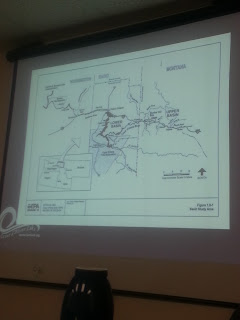Bobby White: Education Outreach Specialist
Coming to Coeur d' Alene was a big eye opener. The shocking truth and scary reality, is that there are no more than 2 fluent elders that speak any Interior Salish language. Coeur d' Alene is a stage 8 language that is in danger of language death.
Coeur d' Alene Tribe was once a sovereign over 5 million acre territory. That was until 1853 when Washington territory was established by Isaac Stevens. By May 1858, the battle of Steptoe came to be. Lt. Col. Steptoe led 150 troops and 50 Nez Perce towards Colville Country, via Palouse. 500 Coeur d' Alene, Spokane, Palouse, Kalispel, and Yakama warriors surrounded them. Chief Vincent, Andrew Seltice, and Peter Wildshoe helped Steptoe retreat. 10 troops and 9 Indians were killed in the conflict.
What resulted from the Battle of Steptoe was not the best. US military wanted to punish the tribes involved. In August of 1858, Col. Wright led a campaign to"pacify" tribes. Wright pursued a "scorched earth" policy which included slaughtering horses, cattle, burning barns, and stored foods. Chiefs were led to his camp to discuss a new peace treaty and instead, Wright had them all hung.
In 1873, Chief Andrew Seltice and former Chief Vincent pursued an agreement with the US government. This was a time of Increases in Encroachments. 598,000 acres were reserved for Coeur d' Alene Tribe with 4 million acres ceded to the US. Compensation included a mill, a blacksmith shop, a school, farm implements, and $170,00. The agreement was declined by congress and the tribe did not receive "title". Slowly, the tribe was losing land along with denial of education. Customs were being stripped away and becoming harder and harder to fight back for what belongs to them.
The second commission began in 1889 leading to cession of northern section of the reservation, with compensation of $500,000. Miners were heavily setting the northern part of the initial reservation and by 1891, the agreement was ratified by congress. Harrison cession in 1894 resulted in today's 345,000 acre reservation boundaries. It may seem like a lot, but there should much more reservation land.
Years to come, the Allotment, also known as The Dawes Act was introduced. It provided land to individual Indians. A patented in few was to be issued to every allottee and only a period of 4 years was to be allowed as well citizenship needed to be conferred upon alottees.
Theodore Roosevelt said in 1901, the Allotment was "a mighty pulvarizing engine to break up the trial mess". At that point, the American Indian population was at its lowest at the turn of the century to about 237,000 people. Thus was known as "The vanishing Indian". Eastern Reformers pushed through the Dawes Act to"enable" the Indians to "acquire civilization". In all, there were 6 specific goals of the Dawes Act. It was to break up the tribe as a social unit, encourage individual initiative, further progress of Indian farmers, reduce cost of reservation as Indian land, and open unused land to white settlers. Native Americans were left with basically nothing. Everything they've owned was stolen from them.
By the 1890's, the Coeur d' Alene's were well known as successful farmers and many of them owned two homes. The Allotment took place by 1909 after the passage of Burke Act. 104,000 acres were allotted to 638 members and "adopted members". The last families living on the lake were evicted in 1911 and Heyburn State Park was established. The money intended for compensation was used by the state to cover the costs of the park. 60 percent of the lands were lost to fee status. Only four Coeur d' Alene families were productively farming by 1921 but today, the tribe retains about 24 percent of 345,000 acre reservation. Although the tribe didn't retrieve most of the land they lost, luckily, the Allotement came to an end in 1928.
There was so much to learn about this presentation and it definitely makes a person more understanding of where each one of us comes from. We've all struggled, lost a part of our culture we may never get back, but it's perseverance and working together that helps keep together what we love the most.
In the end, we're striving to build something stronger. Coeur d' Alene Tribe proves that no matter the situation, love, family, and dedication are what helps each and every one of them grow. Family is everything.

































No comments:
Post a Comment